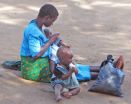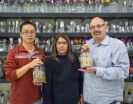(Press-News.org) The largest study of epilepsy in sub-Saharan Africa to date reveals that programmes to control parasitic diseases and access to better antenatal care could substantially reduce the prevalence of the disease in this region.
Epilepsy is one of the most common neurological conditions worldwide and it is well known that it is significantly more prevalent in poorer countries and rural areas. The study of over half a million people in five countries of sub-Saharan Africa is the first to reveal the true extent of the problem and the impact of different risk factors.
The study, conducted at International Network for the Demographic Evaluation of Populations and Their Health (INDEPTH) demographic surveillance sites in Kenya, South Africa, Uganda, Tanzania and Ghana, screened 586,607 residents and identified 1711 who were diagnosed as having active convulsive epilepsy. These individuals, along with 2033 who did not have epilepsy, were given a questionnaire to complete about their lifestyle habits. The team also took blood samples to test for exposure to malaria, HIV and four other parasitic diseases that are common in the developing world.
The team found that adults who had been exposed to parasitic diseases were 1.5-3 times more likely to have epilepsy than those who had not. Epilepsy has previously been linked with various parasite infections but this is the first study to reveal the extent of the problem.
Professor Charles Newton from the Wellcome Trust programme at the Kenyan Medical Research Institute (KEMRI) and the Department of Psychiatry at Oxford University, who led the study, said: "This study demonstrates that many cases of epilepsy could be entirely preventable with elimination of parasites in Africa, some of which for example onchocerciasis have been controlled in some areas. In some areas the incidence of epilepsy could be reduced by 30-60% with appropriate control measures."
In children, the greatest risk factors for developing epilepsy were complications associated with delivery and head injury. Interventions to improve antenatal and perinatal care could substantially reduce the prevalence of epilepsy in this region, say the authors.
The study focused on people with convulsive epilepsies as they are the most reliably detected and reported and there remains a substantial stigma attached to patients with the disease.
"Facilities for diagnosis, treatment and on-going management of epilepsy are virtually non-existent in many of the world's poorest regions and so it's vital that we take these simple steps to try and prevent as many cases of this debilitating disease as possible," Professor Newton added.
### The findings were published today in the journal Lancet Neurology. The study was funded by the Wellcome Trust, with support from the University of the Witwatersrand and the South African Medical Research Council.
Study finds parasites and poor antenatal care are main causes of epilepsy in Africa
2013-01-31
ELSE PRESS RELEASES FROM THIS DATE:
Risk of unwarranted pregnancies with morning after pill conscience clauses
2013-01-31
[The fox and the grapes: an Anglo-Irish perspective on conscientious objection to the supply of emergency hormonal contraception without prescription Online First doi 10.1136/medethics-2012-100975]
Conscience clauses, which allow pharmacists to opt out of providing the "morning after pill" without a prescription, risk unwanted pregnancies and undermine the principle of universal healthcare in the NHS, say pharmacists in the Journal of Medical Ethics.
These clauses should either be banned or enhanced so that pharmacists and patients know exactly where they stand, rather ...
Researchers see more West Nile virus in orchards and vineyards
2013-01-31
PULLMAN, Wash.—Washington State University researchers have linked orchards and vineyards with a greater prevalence of West Nile virus in mosquitoes and the insects' ability to spread the virus to birds, horses and people.
The finding, reported in the latest issue of the journal PLOS ONE, is the most finely scaled look at the interplay between land use and with the virus's activity in key hosts. By giving a more detailed description of how the disease moves across the landscape, it opens the door to management efforts that might bring the disease under control, says David ...
BRI researchers identify biomarker and potential therapy target in multiple sclerosis
2013-01-31
(Seattle, January 30, 2013) Researchers from Benaroya Research Institute at Virginia Mason (BRI) have found that proteins in the IL-6 signaling pathway may be leveraged as novel biomarkers of multiple sclerosis (MS) to gauge disease activity and as a target for new therapies. The research, which investigated how several components involved in immune response differ between MS patient and control samples, was conducted by a team of researchers at BRI led by Dr. Jane Buckner in collaboration with Dr. Mariko Kita at Virginia Mason Medical Center and was published today in ...
3D microchip created
2013-01-31
Scientists from the University of Cambridge have created, for the first time, a new type of microchip which allows information to travel in three dimensions. Currently, microchips can only pass digital information in a very limited way - from either left to right or front to back. The research was published today, 31 January, in Nature.
Dr Reinoud Lavrijsen, an author on the paper from the University of Cambridge, said: "Today's chips are like bungalows – everything happens on the same floor. We've created the stairways allowing information to pass between floors."
Researchers ...
Disasters can prompt older children to be more giving, younger children to be more selfish
2013-01-31
A natural disaster can bring out the best in older children, prompting 9-year-olds to be more willing to share, while 6-year-olds become more selfish. Researchers at the University of Toronto, the University of Chicago, and Liaoning Normal University made this finding in a rare natural experiment in China around the time of a horrific earthquake.
A crucial difference between the two age groups emerged one month after the disaster. The 6-year-olds' willingness to share in a test measuring altruism dropped by a third, while among 9-year-olds, willingness to give to others ...
Doubt cast on Sir Bernard Lovell's brainwashing
2013-01-31
In this month's edition of Physics World, science writer Richard Corfield casts doubt on the alleged "brainwashing" of the late British astronomer Sir Bernard Lovell by the Soviets at the height of the Cold War and explains how his trips beyond the Iron Curtain laid the foundations for the easing of geopolitical tensions between the UK and the USSR.
Speaking to Lovell's son Bryan, Corfield reveals a more mundane explanation for why Lovell, who founded the Jodrell Bank telescope in the UK, fell ill on his return from the USSR in 1963.
"For me the more likely explanation ...
Gut microbes at root of severe malnutrition in kids
2013-01-31
A study of young twins in Malawi, in sub-Saharan Africa, finds that bacteria living in the intestine are an underlying cause of a form of severe acute childhood malnutrition.
The research, led by Washington University School of Medicine in St. Louis and reported Feb. 1 in the journal Science, shows how dysfunctional communities of gut microbes conspire with a poor diet to trigger malnutrition.
The discovery is bolstered by additional studies in mice, showing that gut microbes transplanted from malnourished children cause dramatic weight loss and alter metabolism when ...
Biofuels blend right in
2013-01-31
Winemakers have long known that blending different grape varietals can favorably balance the flavor characteristics of the wine they produce. In the future, makers of advanced biofuels might use a similar strategy, blending different feedstock varieties to balance the energy characteristics of the transportation fuel they produce.
A collaborative study by researchers with the U.S. Department of Energy (DOE)'s Joint BioEnergy Institute (JBEI), a bioenergy research center led by Berkeley Lab, and the Idaho National Laboratory (INL) has shown that an ionic liquid proven ...
In beef production, cow-calf phase contributes most greenhouse gases
2013-01-31
Jan. 30 2013 - Scientists have long known that cattle produce carbon dioxide and methane throughout their lives, but a new study pinpoints the cow-calf stage as a major contributor of greenhouse gases during beef production.
In a new paper for the Journal of Animal Science, scientists estimate greenhouse gas emissions from beef cattle during different stages of life. They show that, depending on which production system farmers used, beef production has a carbon footprint ranging from 10.7 to 22.6 kg of carbon dioxide equivalent per kg of hot carcass weight.
According ...
Confirmed: How plant communities endure stress
2013-01-31
PROVIDENCE, R.I. [Brown University] — Ecology is rife with predation, competition, and other dramatic "negative interactions," but those alone do not determine the course life on Earth. Organisms sometimes benefit each other, too, and according to the Stress Gradient Hypothesis, their "positive interactions" become measurably more influential when ecosystems become threatened by conditions such as drought. Ecologists have argued about the hypothesis ever since Brown University ecologist Mark Bertness co-proposed it in 1994; Bertness says a large new global meta-analysis ...


